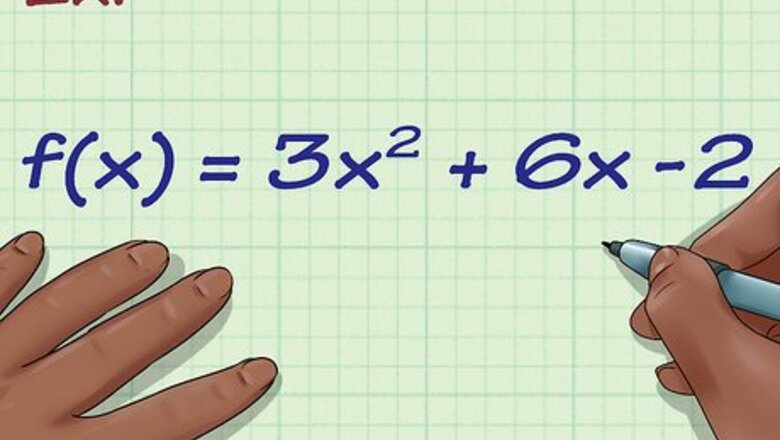
views
Finding the Range of a Function Given a Formula
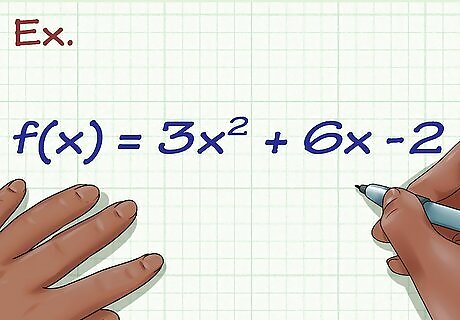
Write down the formula. Let's say the formula you're working with is the following: f(x) = 3x + 6x -2. This means that when you place any x into the equation, you'll get your y value. This is the function of a parabola.
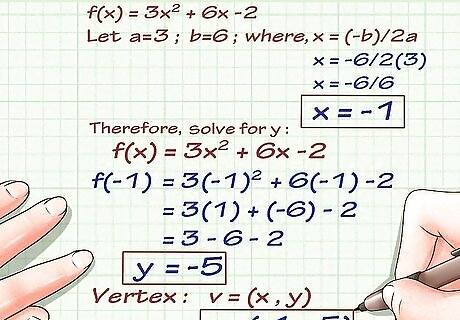
Find the vertex of the function if it's quadratic. If you're working with a straight line or any function with a polynomial of an odd number, such as f(x) = 6x+2x + 7, you can skip this step. But if you're working with a parabola, or any equation where the x-coordinate is squared or raised to an even power, you'll need to plot the vertex. To do this, just use the formula -b/2a to get the x coordinate of the function 3x + 6x -2, where 3 = a, 6 = b, and -2 = c. In this case -b is -6, and 2a is 6, so the x-coordinate is -6/6, or -1. Now, plug -1 into the function to get the y-coordinate. f(-1) = 3(-1) + 6(-1) -2 = 3 - 6 -2 = -5. The vertex is (-1,-5). Graph it by drawing a point where the x coordinate is -1 and where the y-coordinate is -5. It should be in the third quadrant of the graph.
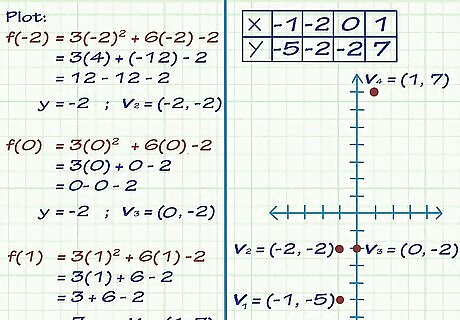
Find a few other points in the function. To get a sense of the function, you should plug in a few other x-coordinates so you can get a sense of what the function looks like before you start to look for the range. Since it's a parabola and the x coordinate is positive, it'll be pointing upward. But just to cover your bases, let's plug in some x-coordinates to see what y coordinates they yield: f(-2) = 3(-2) + 6(-2) -2 = -2. One point on the graph is (-2, -2) f(0) = 3(0) + 6(0) -2 = -2. Another point on the graph is (0,-2) f(1) = 3(1) + 6(1) -2 = 7. A third point on the graph is (1, 7).
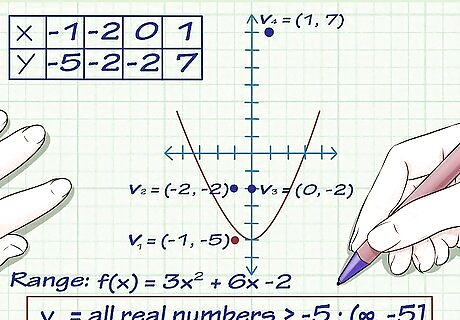
Find the range on the graph. Now, look at the y-coordinates on the graph and find the lowest point at which the graph touches a y-coordinate. In this case, the lowest y-coordinate is at the vertex, -5, and the graph extends infinitely above this point. This means that the range of the function is y = all real numbers ≥ -5.
Finding the Range of a Function on a Graph
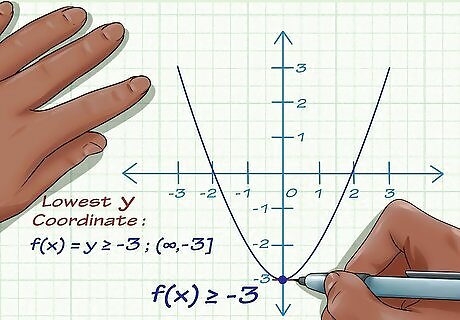
Find the minimum of the function. Look for the lowest y-coordinate of the function. Let's say the function reaches its lowest point at -3. This function could also get smaller and smaller infinitely, so that it doesn't have a set lowest point -- just infinity.
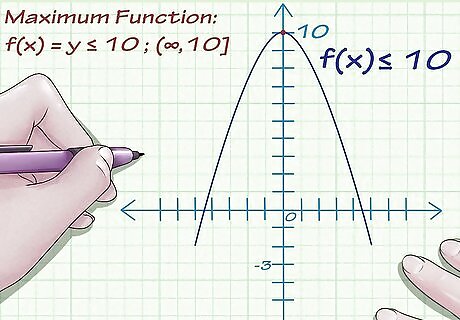
Find the maximum of the function. Let's say the highest y-coordinate that the function reaches is 10. This function could also get larger and larger infinitely, so it doesn't have a set highest point -- just infinity.
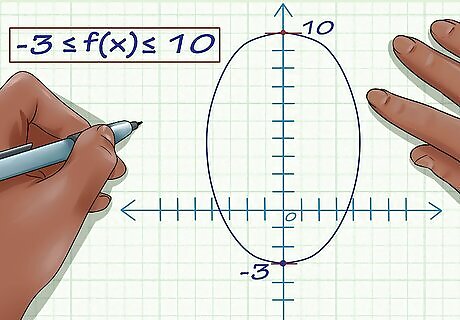
State the range. This means that the range of the function, or the range of y-coordinates, ranges from -3 to 10. So, -3 ≤ f(x) ≤ 10. That's the range of the function. But let's say the graph reaches its lowest point at y = -3, but goes upward forever. Then the range is f(x) ≥ -3 and that's it. Let's say the graph reaches its highest point at 10 but goes downward forever. Then the range is f(x) ≤ 10.
Finding the Range of a Function of a Relation
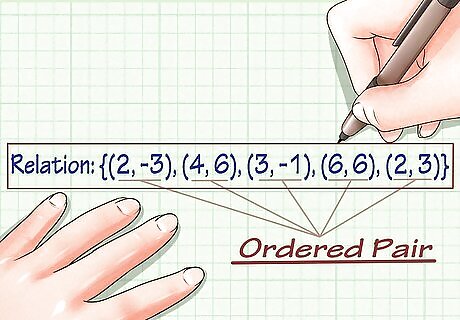
Write down the relation. A relation is a set of ordered pairs with of x and y coordinates. You can look at a relation and determine its domain and range. Let's say you're working with the following relation: {(2, –3), (4, 6), (3, –1), (6, 6), (2, 3)}.

List the y-coordinates of the relation. To find the range of the relation, simply write down all of the y-coordinates of each ordered pair: {-3, 6, -1, 6, 3}.
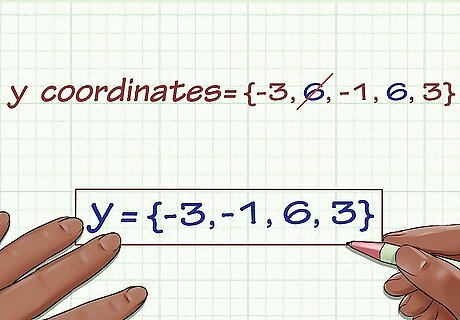
Remove any duplicate coordinates so that you only have one of each y-coordinate. You'll notice that you have listed "6" two times. Take it out so that you are left with {-3, -1, 6, 3}.
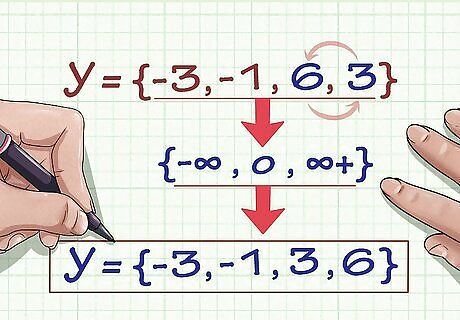
Write the range of the relation in ascending order. Now, reorder the numbers in the set so that you're moving from the smallest to the largest, and you have your range. The range of the relation {(2, –3), (4, 6), (3, –1), (6, 6), (2, 3)} is {-3,-1, 3, 6}. You're all done.
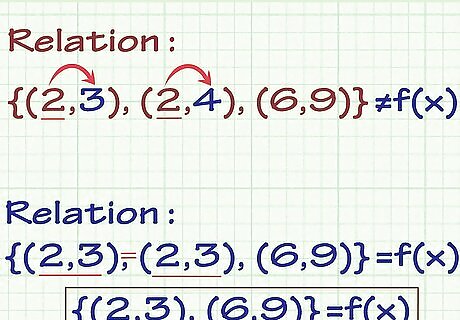
Make sure that the relation is a function. For a relation to be a function, every time you put in one number of an x coordinate, the y coordinate has to be the same. For example, the relation {(2, 3) (2, 4) (6, 9)} is not a function, because when you put in 2 as an x the first time, you got a 3, but the second time you put in a 2, you got a four. For a relation to be a function, if you put in the same input, you should always get the same output. If you put in a -7, you should get the same y coordinate (whatever it may be) every single time.
Finding the Range of a Function in a Word Problem

Read the problem. Let's say you're working with the following problem: "Becky is selling tickets to her school's talent show for 5 dollars each. The amount of money she collects is a function of how many tickets she sells. What is the range of the function?"

Write the problem as a function. In this case, M represents the amount of money she collects, and t represents the amount of tickets she sells. However, since each ticket will cost 5 dollars, you'll have to multiply the amount of tickets sold by 5 to find the amount of money. Therefore, the function can be written as M(t) = 5t. For example, if she sells 2 tickets, you'll have to multiply 2 by 5 to get 10, the amount of dollars she'll get.
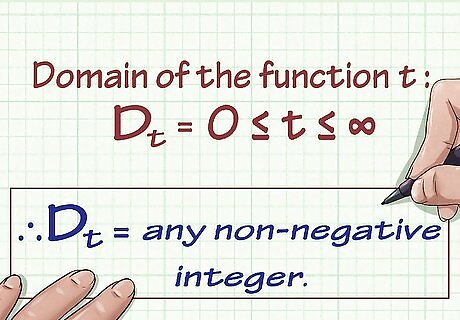
Determine the domain. To determine the range, you must first find the domain. The domain is all of the possible values of t that work in the equation. In this case, Becky can sell 0 or more tickets - she can't sell negative tickets. Since we don't know the number of seats in her school auditorium, we can assume that she can theoretically sell an infinite number of tickets. And she can only sell whole tickets; she can't sell 1/2 of a ticket, for example. Therefore, the domain of the function is t = any non-negative integer.
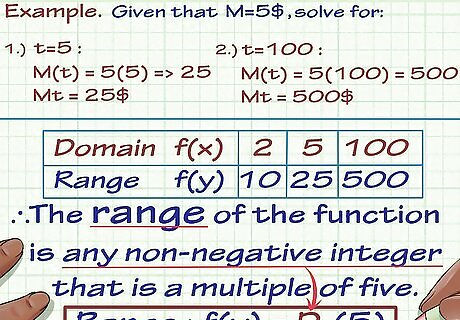
Determine the range. The range is the possible amount of money that Becky can make from her sale. You have to work with the domain to find the range. If you know that the domain is any non-negative integer and that the formula is M(t) = 5t, then you know that you can plug any non-negative integer into this function to get the output, or the range. For example, if she sells 5 tickets, then M(5) = 5 x 5, or 25 dollars. If she sells 100, then M(100) = 5 x 100, or 500 dollars. Therefore, the range of the function is any non-negative integer that is a multiple of five. That means that any non-negative integer that is a multiple of five is a possible output for the input of the function.

















Comments
0 comment